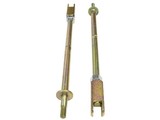These rods have been produced to improve car stability when cornering and braking and to facilitate easy adjustment of caster angle. Manufactured from a high-grade material in a much larger diameter than the standard items they are far less susceptible to bending - both in use and where poor workshop practice is observed. The most common fault here is jacking the car up with a trolley jack sitting the cup up against the forward tie-rod mounting bracket on the front subframe. As the wheel droops, the tie-rod becomes bound hard up against the jack cup, the sheer force of the un-loading rubber spring causing the insubstantial standard tie-rod to bend. This effectively shortens the tie-rod, therefore increasing caster angle.
The standard caster angle quoted by the workshop manual is 3 degrees +0/-2, so could be anything from 1 to 3 degrees and not necessarily equal on each side. Caster angle will change when raising or lowering the car and where adjustable or fixed negative camber bottom arms are used (increasing camber tends to also increase caster angle). The adjustability of these tie rods allows accurate and equal setting of the caster angle on both sides of the car. This is imperative for straight line stability and minimalising wander/weaving over broken road surfaces - particularly where 13" wheels and limited slip differentials are used. The greater the caster angle, the more self-centering action will be when accelerating. Increased caster also improves cornering grip.
Adjustment is achieved by screwing the tie rod in or out of the threaded block that bolts to the bottom arm. This can be done without removing the tie rod from it's installed position by slackening the 11/16"AF nut on the front end of the tie rod, undoing the lock nut that tightens up against the adjuster block then turning the toe rod with a spanner on the hexagonal shape cut into the tie rod shaft's centre. Shortening the rod by screwing it into the adjuster block increases caster, lengthening it by un-screwing it out of the adjuster block decreases caster.
The standard tie rod length is 14.25" measured from the inner edge of the bottom arm retaining bolt hole to the outer face of the welded-on washer. One full rotation of the rod adjusts the length by 1/16", which equates to a little over 1/2 degree. However, the shorter the tie rod is made, the less amount of alteration is achieved. It is not recommended to use more than 5.5 degrees of caster, less than 2 degrees will greatly reduce the steering's self-centering action. Altering caster angle also alters camber angle - increasing caster angle reduces camber and vice versa. Always start with the tie rod set at the standard length. Starting with the rod longer can cause a misleading phenomena known as the 'tea trolley' effect, where the bottom ball joint (swivel pin) is behind the top one viewed in side elevation.
IMPORTANT NOTE:
The use of very stiff/hard tie rod bushings on both sides of the subframe bracket is most definitely NOT recommended. Use the hard bushing on the outside only and a standard rubber bushing on the inner side. This is to prevent the tie rod end shearing off through over-stressing when doing the retaining nut up to achieve the required seating of the retaining washer against the step on the tie rod, and is more than sufficient to create the increased stability desired when fitting these harder bushings. It is also imperative the proper, standard fitment cup and flat washers be used to maintain proper performance of the bushings fitted. The tyre trying to drag the tie rod back through the subframe mainly creates the instability, therefore only the outer bushing requires increased resilience. Fitting harder bushings on both sides does not noticeably improve stability, nor cornering performance. If determined to use harder bushings on both sides of the tie-rod forward mounting bracket, then it is strongly advisable to cut the one to be fitted to the inside between the tie-rod welded-on washer and subframe bracket in half (vertically) to allow the outer nut and washers to achieve their correct positions without over-stressing the threaded end. Failure to observe all information here is likely to cause failure at the threaded section.
Useful part numbers:
| 31G1155 | Standard rubber tie-rod bushings (need 4 per car) |
| C-STR627 | Extremely stiff 'race' application tie-rod bushings (1 set per car) |
| C-STR628 | Performance street application tie-rod bushings (1 set per car) |
| 21A1091 | Heavy-duty adjustable tie-rods only (pair) |
| ACA9759 | Cup washer (2 per car) |
| PWZ207 | Flat washer (2 per car) |
| GHF3224 | Retaining nut (2 per car) |
| 53K1031 | Tie-rod to bottom arm fixing bolt (2 per car) |
| GHF332 | Spring washer - tie-rod to bottom arm fixing bolt (2 per car) |
| FNZ505 | Nut - tie-rod to bottom arm fixing bolt (2 per car) |









